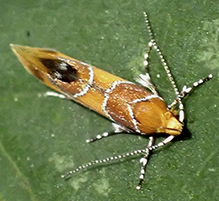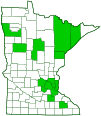orange-headed epicallima
(Callima argenticinctella)
Conservation • Description • Habitat • Ecology • Distribution • Taxonomy
|
||||||||
| Hodges # | 1046 |
|||||||
Conservation Status |
||||||||
| IUCN Red List | not listed |
|||||||
| NatureServe | NNR - Unranked SNR - Unranked |
|||||||
| Minnesota | not listed |
|||||||
Description |
||
Orange-headed epicallima is a common, very small, brightly colored, easily recognized, concealer moth. It occurs in the United States and southern Canada east of the Great Plains. In the south, adults are active from April through early September. In Minnesota, they are active from June through August. They are found in deciduous and mixed forests and in wooded residential areas. Larvae are usually found under the bark of deciduous trees and shrubs, including hickory, oak, tamarack, elderberry, and elm. They probably feed on fungus. Adults are ¼″ (6 to 7 mm) in length and have a ⅜″ to ½″ (10 to 13 mm) wingspan. The head is pale yellow to golden yellow. There are two compound eyes and no simple eyes (ocelli). The antennae are long, at least three-fifths the length of the forewing. They are banded black and white. The finger-like sensory organs on the upper part of the mouth (labial palps) are long and cycle-shaped, curved upward and backward. They have three segments and are smoothly scaled. The second segment is blackish-brown. The third segment is banded black and white. The thorax is yellowish-brown. The forewings are long, narrow, and rounded at the tip. They are pale yellow to golden yellow with dark patches and white lines. The color of the patches is variable. They may be dark brown, brownish-red, orange, or light orangish-brown. The lines are silvery-white and are always edged with black scales. Occasionally, one of the lines is lead gray. In the basal area there is a broad dark band edged in front and behind by white lines. The band starts at the inner margin and terminates just before reaching the leading edge (costal margin). A second band at the anal angle begins at the inner margin and extends just halfway to the costal margin. This band is dusted with black scales and is edged on all three sides by white lines. Sometimes the rear band connects with the front band, continues to the costal margin, or continues to the wingtip, or any combination of these. The kidney-shaped spot (reniform spot) is represented by a broad white line extending rearward at an angle from the midpoint of the costal margin toward but not reaching the second dark band. The fringe is very long and mostly golden yellow, blackish-brown just near the anal angle. All 12 veins are present. Vein 1A is present, at least at the margin. Veins 2A and 3A are forked at the base. The hindwing is gray or blackish-brown, with a very long fringe of the same color. It is broadly lance-shaped to almost square, and the outer margin is rounded. Veins Rs and M1 are separate and parallel, and veins Sc and Rs are separate and parallel. The legs are black and white. |
||
Size |
||
Total length: ¼″ (6 to 7 mm) Wingspan: ⅜″ to ½″ (10 to 13 mm) |
||
Similar Species |
||
Habitat |
||
Deciduous and mixed forests and in wooded residential areas |
||
Ecology |
||
Season |
||
One generation per year: April through early September in the south, June through August in Minnesota. |
||
Behavior |
||
Adults are active at night and will come to ultraviolet light. |
||
Life Cycle |
||
Little is known of the biology of larvae in the Oecophoridae family. |
||
Larva Food |
||
Probably fungus on the dead wood of deciduous trees and shrubs, including hickory, oak, tamarack, elderberry, and elm. |
||
Adult Food |
||
|
||
Distribution |
||||
|
Sources |
|||
| 7/23/2023 | ||||
Occurrence |
||||
Common and sometimes abundant |
||||
Taxonomy |
|||
Order |
Lepidoptera (Butterflies and Moths) | ||
Superfamily |
Gelechioidea (curved-horn moths) | ||
Family |
Oecophoridae (concealer moths) | ||
Subfamily |
Oecophorinae | ||
Tribe |
Oecophorini | ||
Genus |
Callima | ||
|
|||
This moth was originally described as Callima argenticinctella in 1860. The scientific name was changed to Epicallima argenticinctella in 1903 by Harrison G. Dyar. However, this change was later ruled invalid by the International Code of Zoological Nomenclature (ICZN) in 1974, and the name Callima argenticinctella was restored. The reason for the change in 1903 was that the genus Callima was thought to be a homonym of the genus Callima Herrich-Schäffer, 1858, which was actually a misspelling of the name Kallima Westwood, 1849. However, the ICZN ruled that the name Callima Clemens, 1860, was not a homonym of Callima Herrich-Schäffer, 1858, and therefore the name Epicallima argenticinctella was invalid. Therefore, the current scientific name of the moth is Callima argenticinctella. With very few exceptions, almost all sources currently use the name Epicallima argenticinctella. Those exceptions include Moth Photographers Group, BugGuide.net, and HOSTS - a Database of the World's Lepidopteran Hostplants. The common name, however, remains orange-headed epicallima. |
|||
Synonyms |
|||
Epicallima argenticinctella |
|||
Common Names |
|||
orange-headed epicallima orange-headed epicallima moth |
|||
Glossary
Costal margin
The leading edge of the forewing of insects.
Ocellus
Simple eye; an eye with a single lens. Plural: ocelli.
Palp
Short for pedipalp. A segmented, finger-like process of an arthropod; one is attached to each maxilla and two are attached to the labium. They function as sense organs in spiders and insects, and as weapons in scorpions. Plural: palpi or palps.
Reniform spot
A kidney-shaped spot or outline in the lower median area near the PM line on the forewing of many moths.
Visitor Photos |
|||||
Share your photo of this insect. |
|||||
| This button not working for you? Simply email us at info@MinnesotaSeasons.com. Attach one or more photos and, if you like, a caption. |
|||||
Babette Kis |
|||||
Callima argenticinctella - Orange-headed Epicallima Orange-headed Epicallima, on Aster sp. leaf, Barnes Prairie, Racine Co., WI. Photo was taken late afternoon on July 25, 2021. Moth was about 8 mm long. |
 |
||||
MinnesotaSeasons.com Photos |
|||||
|
|||||

Slideshows |
||

Visitor Videos |
|||
Share your video of this insect. |
|||
| This button not working for you? Simply email us at info@MinnesotaSeasons.com. Attach a video, a YouTube link, or a cloud storage link. |
|||
Other Videos |
|||


Created: 7/23/2023
Last Updated:

